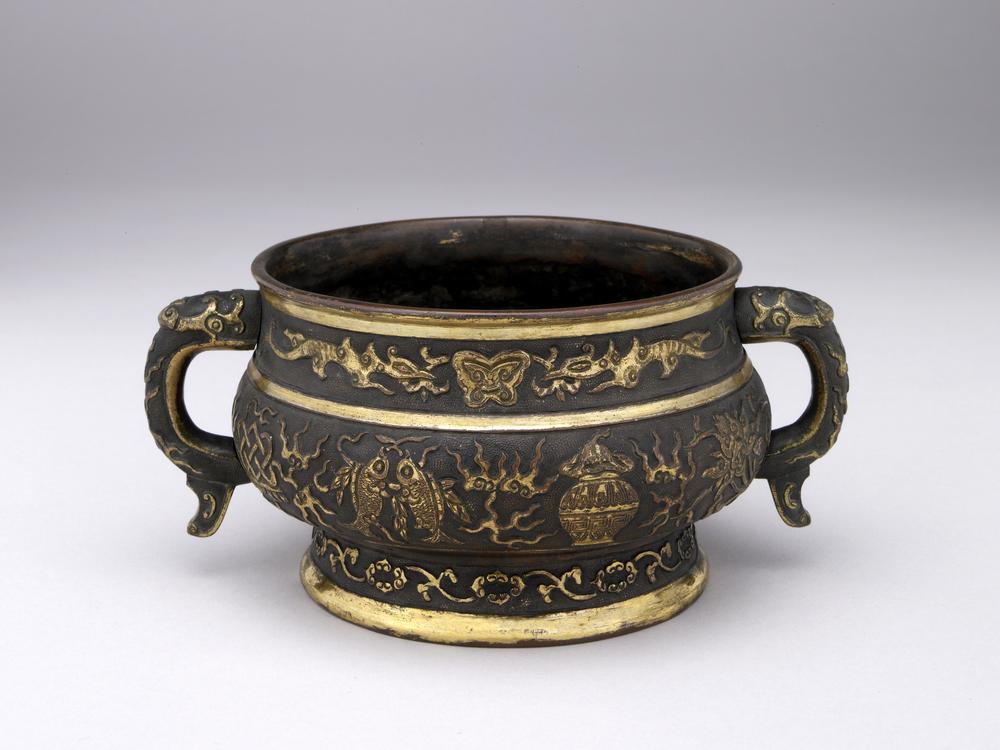Period:Five Dynasties and Ten Kingdoms Production date:10thC
Materials:silk, 絲綢 (Chinese),
Technique:painted
Subjects:lokapala canopy devil/demon arms/armour 天王 (Chinese) 華蓋 (Chinese) 魔鬼/惡魔 (Chinese) 武器/盔甲 (Chinese)
Dimensions:Height: 64.50 centimetres Width: 17.50 centimetres
Description:
Brightly coloured, well-preserved banner with lokapala Virūpākṣa, Guardian of the West, standing on demon, holding a sword. The purple cloud above his halo appears to form a canopy. The banner’s triangular headpiece is of rose-coloured silk, with a green suspension loop and patterned green side-streamers. Painted in ink and colours on silk.
IMG
![图片[1]-painting; banner; 繪畫(Chinese); 幡(Chinese) BM-1919-0101-0.108-China Archive](https://chinaarchive.net/Five Dynasties and Ten Kingdoms/Paintings/mid_00000109_001.jpg)
![图片[2]-painting; banner; 繪畫(Chinese); 幡(Chinese) BM-1919-0101-0.108-China Archive](https://chinaarchive.net/Five Dynasties and Ten Kingdoms/Paintings/mid_RFC721.jpg)
Comments:EnglishFrom Whitfield 1982:Although the bottom streamers of sage-green silk are now separately preserved, this banner when found was complete except for the weighting board and still makes a splendid impression with its wide headpiece of thin rose-coloured silk and side streamers of green silk with flowers, birds and insects in dark blue or possibly silver. The suspension loop is of a thick silk with a pattern in green like MAS 858 (Vol. 3, Pl. 6). The painted area has narrow red edges with small florets in white. The Lokapāla and the demon he stands on are almost perfectly preserved, a large piece of bright blue silk having been tacked behind the top of the painting to prevent it falling apart. Whit the purple cloud rising to form, as it were, a canopy above the halo, the painting is close to two paintings of Virūpāksa’s eastern counterpart, Dhrtarāstra, from the Pelliot collection (Bannieres, Nos. 193, 194).As considered by Stein in Serindia, the Lokapāla paintings in the collection (twenty-four in all, including those in New Delhi) were divided into two categories, those with features relating them to the more “Indian ”of the Bodhisattva banners, such as Pl. 62, and those more Chinese, such as the present banner (Stein, Serindia, pp. 939-41, 1032-33). In actual fact, despite some differences, the whole group is fairly homogeneous and simply presents a range of types. All may be regarded as being painted at Dunhuang, rather than having been brought there from elsewhere. ChineseFrom Whitfield 1982:發現此幡時,除了缺少鎮板外,形狀還很完整,現在底部的黃綠色幡腳被單獨保存。薔薇色薄絹的大型幡首和綠色絹底上,用藏藍色或銀泥描繪着花、鳥、蟲等兩側的幡尾等,至今仍給人華麗的印象。吊環與MAS858(第3卷圖6)包經卷的布相似,由綠色花紋的厚絹做成。畫面的兩側加了紅底上撒滿白色小花紋樣的細邊飾。廣目天和腳下的地鬼大體保存完好,繪畫上部從內側安了大塊亮青色的絹子,此補修可使繪畫不易脫落。頭光上方騰起紫色雲彩,看似華蓋。從這種表現看,此畫與伯希和收集品中的兩件持國天近似(參見《敦煌的幡和繪畫》篇圖版193、194)。在《西域》中,斯坦因把收集品中的天王像(包括新德里國立博物館的部分,共有24件)分爲兩類(參照《西域》,p.939-941,p.1032-1033),即與“印度式” 對應的圖62等菩薩幡畫群,及與“中國式”對應的本菩薩幡畫群。其實,虽然多少有些差別,但大體上都屬同一性質,可以說只是各類型的不同展現而已。因此所有的都不應是從別處帶入的,而應該是在敦煌製作的。
Materials:silk, 絲綢 (Chinese),
Technique:painted
Subjects:lokapala canopy devil/demon arms/armour 天王 (Chinese) 華蓋 (Chinese) 魔鬼/惡魔 (Chinese) 武器/盔甲 (Chinese)
Dimensions:Height: 64.50 centimetres Width: 17.50 centimetres
Description:
Brightly coloured, well-preserved banner with lokapala Virūpākṣa, Guardian of the West, standing on demon, holding a sword. The purple cloud above his halo appears to form a canopy. The banner’s triangular headpiece is of rose-coloured silk, with a green suspension loop and patterned green side-streamers. Painted in ink and colours on silk.
IMG
![图片[1]-painting; banner; 繪畫(Chinese); 幡(Chinese) BM-1919-0101-0.108-China Archive](https://chinaarchive.net/Five Dynasties and Ten Kingdoms/Paintings/mid_00000109_001.jpg)
![图片[2]-painting; banner; 繪畫(Chinese); 幡(Chinese) BM-1919-0101-0.108-China Archive](https://chinaarchive.net/Five Dynasties and Ten Kingdoms/Paintings/mid_RFC721.jpg)
Comments:EnglishFrom Whitfield 1982:Although the bottom streamers of sage-green silk are now separately preserved, this banner when found was complete except for the weighting board and still makes a splendid impression with its wide headpiece of thin rose-coloured silk and side streamers of green silk with flowers, birds and insects in dark blue or possibly silver. The suspension loop is of a thick silk with a pattern in green like MAS 858 (Vol. 3, Pl. 6). The painted area has narrow red edges with small florets in white. The Lokapāla and the demon he stands on are almost perfectly preserved, a large piece of bright blue silk having been tacked behind the top of the painting to prevent it falling apart. Whit the purple cloud rising to form, as it were, a canopy above the halo, the painting is close to two paintings of Virūpāksa’s eastern counterpart, Dhrtarāstra, from the Pelliot collection (Bannieres, Nos. 193, 194).As considered by Stein in Serindia, the Lokapāla paintings in the collection (twenty-four in all, including those in New Delhi) were divided into two categories, those with features relating them to the more “Indian ”of the Bodhisattva banners, such as Pl. 62, and those more Chinese, such as the present banner (Stein, Serindia, pp. 939-41, 1032-33). In actual fact, despite some differences, the whole group is fairly homogeneous and simply presents a range of types. All may be regarded as being painted at Dunhuang, rather than having been brought there from elsewhere. ChineseFrom Whitfield 1982:發現此幡時,除了缺少鎮板外,形狀還很完整,現在底部的黃綠色幡腳被單獨保存。薔薇色薄絹的大型幡首和綠色絹底上,用藏藍色或銀泥描繪着花、鳥、蟲等兩側的幡尾等,至今仍給人華麗的印象。吊環與MAS858(第3卷圖6)包經卷的布相似,由綠色花紋的厚絹做成。畫面的兩側加了紅底上撒滿白色小花紋樣的細邊飾。廣目天和腳下的地鬼大體保存完好,繪畫上部從內側安了大塊亮青色的絹子,此補修可使繪畫不易脫落。頭光上方騰起紫色雲彩,看似華蓋。從這種表現看,此畫與伯希和收集品中的兩件持國天近似(參見《敦煌的幡和繪畫》篇圖版193、194)。在《西域》中,斯坦因把收集品中的天王像(包括新德里國立博物館的部分,共有24件)分爲兩類(參照《西域》,p.939-941,p.1032-1033),即與“印度式” 對應的圖62等菩薩幡畫群,及與“中國式”對應的本菩薩幡畫群。其實,虽然多少有些差別,但大體上都屬同一性質,可以說只是各類型的不同展現而已。因此所有的都不應是從別處帶入的,而應該是在敦煌製作的。
© Copyright
The copyright of the article belongs to the author, please keep the original link for reprinting.
THE END
![[Qing Dynasty] British female painter—Elizabeth Keith, using woodblock prints to record China from the late Qing Dynasty to the early Republic of China—1915-China Archive](https://chinaarchive.net/wp-content/uploads/2022/11/image-191x300.png)




